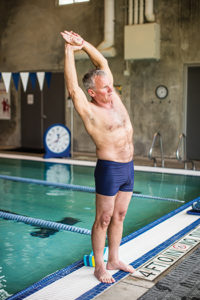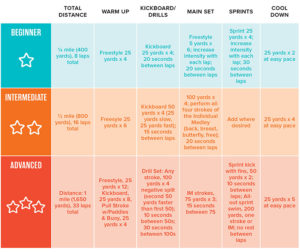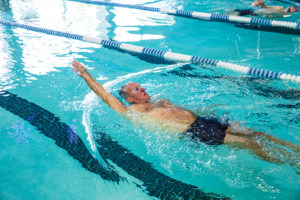Workout of the Month

Swim Workout at the YMCA
According to the Centers for Disease Control, an average person can burn 250 calories by swimming laps for 30 minutes at a moderate pace, and more than 800 calories for an hour at a vigorous pace.
“Swimming is a great sport for general fitness because it’s low-impact, easy on the joints, and you can get a great full-body workout in a short amount of time,” says James Finck, YMCA of Austin President and CEO.
Finck enjoys swimming because it doesn’t require the repetitive physical stress that comes from pounding the pavement, spinning pedals or other land-based exercises. He also likes the solitude, stress relief and mental clarity the water gives him.

Components of a Swim Workout
Warm Up: When you get to the pool deck and get situated, do a few quick arm rotations and dry-land swimming drills. Even some stretching, core strengthening and exercises with elastic bands can help get your upper body prepped and ready for your swim workout.
Drill Set: After you have done a thorough warm-up, it is time to move on quickly to a drill set to get your arms moving and heart rate up. A drill set will be a bit faster than your warm-up, but not as hard as your main set. The primary goal is to focus on good swim technique before fatigue sets in.
Main Set: After your drill set is complete, a quick one-minute break is all you need to determine your main set, the goal of your workout. Your swim workout goal can be broken into three types: Speed/sprinting/lactate threshold sets; Technique/strength sets; Distance/endurance sets. Workouts will vary depending on your goal for the day.
Cool Down: After completing your main set, perform a quick cool down to end your swim workout. Similar to running or other exercise, a short regimen of light activity followed by stretching can reduce soreness and prevent injury.

A Note About Water Jogging/Walking
Even if you’re not inclined toward lap swimming, the pool can offer other great workout options. Water jogging/walking involves mimicking the motion of running or walking in the deep end of the pool, and it is zero impact and safe for almost any type of injuries, especially if you are recovering from tendinitis, bursitis, torn cartilage or a stress fracture. Just move your legs and swing your arms as if you were running with the goal of keeping your head above water. Be sure to keep your body straight upright rather than leaning forward.

Swimming Workout Glossary
Backstroke – A swimming stroke performed on the back with the arms lifted alternately out of the water in a backward circular motion and the legs extended and kicking.
Breast Stroke – A stroke in which the arms are pushed forward and then swept back in a circular movement, while the legs are tucked in toward the body and then kicked out in a corresponding movement (also known as a frog kick).
Butterfly – A stroke in which both arms are raised out of the water and lifted forwards together.
Freestyle – Often used as a synonym with “Front Crawl,” this is the most common stroke in swimming, characterized by alternating arm and kick while breathing to side.
Individual Medley – A combination of four different swimming strokes – butterfly, backstroke, breaststroke and freestyle – usually in a specific order.
Kick/Kicking – Using only your legs to propel yourself through the water. Kicking can be done using a kickboard or with arms extended and either on your stomach or back.
Negative Split – Swimming the second half of a distance at a faster pace than the first half.
Pull – Commonly refers to drills performed with a plastic foam pull buoy placed between the legs and/or hand paddles to concentrate on the pull without kicking.
Water Jogging or Walking – A low-impact alternative to land-based activities, water jogging is performed in an upright position while swinging the arms through the water. A flotation belt is optional.






